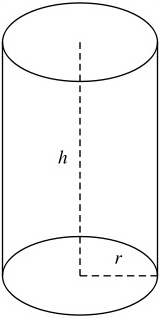Cylinder

A cylinder is taken to mean a finite section of a right circular cylinder with its ends closed to form two circular surfaces, as in the figure above. If the cylinder has a radius r and length (height) h, then its volume is given by
V = πr2h
and its surface area is:
- Area of the top is πr2
- Area of the bottom is πr2
- Area of the side is 2πrh
Therefore without the top or bottom, the surface area is
- A = 2πrh
With the top and bottom, the surface area is
- A = 2πr2 + 2πrh = 2πr(r + h)
For a given volume, the cylinder with the smallest surface area has h = 2r. For a given surface area, the cylinder with the largest volume has h = 2r, (i.e. cylinder fits in a cube (height = diameter.)
Related Topics:


